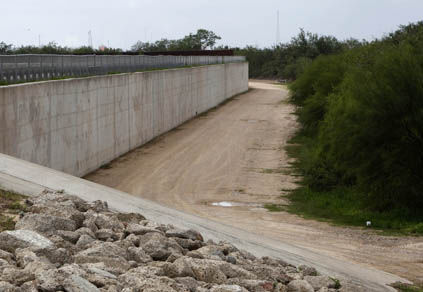Cameron County Commissioners Court passed a resolution opposing U.S. Customs and Border Protection’s border wall construction efforts in the Rio Grande Valley.
Commissioners approved the item, which was placed on the consent agenda, with no discussion.
Cameron County Judge Eddie Treviño Jr. said the commission felt it was important to put their opposition on the record.
“ We’re hearing that there is still consideration and thought and discussions being made with the building of additional border wall structures, not just fencing, but structures, but among them, in environmentally sensitive areas, such as the Santa Ana Wildlife Refuge,” he said.
He also said Commissioners Court is concerned that more border wall, which has existed here for a decade, is not the best use of limited federal dollars, which could be better used at ports-of-entry to improve drug interdiction efforts.
“ And the idea of saying the border is insecure as justification to build border wall, we just disagree with that anti-immigrant rhetoric,” he said.
The county passed a similar resolution in 2017, but at the time, public plans for President Donald Trump’s border wall focused on Hidalgo and Starr counties.
That’s now changed.
In July, CBP published notices in The Brownsville Herald, The Valley Morning Star and The Monitor, soliciting public comments on the location and potential impacts of border barrier projects, including 19 miles of levee or border wall in Cameron County.
CBP is planning in 11 areas from the Hidalgo/Cameron County line to Brownsville, where federal authorities want to build a little more than 11 miles of border wall.
The government also intends to build 1.2 miles of new border wall south of Los Indios, another 3.8 miles are planned southeast of Bluetown with a final stretch of 2.7 miles south of Santa Maria, at the county line.
The federal government’s intentions for new border wall, however, became clear in May, when authorities filed two land condemnation lawsuits against Brownsville residents seeking right-of-entry for the purposes of surveying for a border wall.
A total of four land condemnation lawsuits have been filed since then and CBP has circulated letters to residents in the River Bend Resort & Golf Club signaling the agency’s plans to begin building border wall in that area in 2020.
Two of the parties sued in the land condemnation cases have reached agreements with the federal government resulting in the closure of the lawsuits against them.
Yvette Arroyo and her husband, Salvador J. Castillo, who heads the county’s Veteran Services Department, filed a joint motion with the government Tuesday seeking a court order granting the federal government possession of a temporary easement and to establish just compensation.
The motion recommends $100 as just compensation, but says Arroyo and Castillo reserve the right to seek damages in a separate action if any damage is not repaired at the end of the 12-month temporary easement.
The proposed agreement allows United States employees and contractors the right to enter their property, the home they live in with their children, and temporarily store equipment there. The agreement would also allow the government the right to remove vegetation or structural obstacles impeding its surveying.
However, the proposal states that the United States will not trim or remove trees or a wooden fence without prior authorization.
The couple’s backyard features a line of trees along a fence line that is just feet from a levee.
In the other agreement resulting in a dismissal of a land condemnation lawsuit, Jaime and Rocio Trevino, who live in the same neighborhood as Castillo and Arroyo, signed a stipulation of dismissal.
That document, however, does not detail whether the parties reached an agreement on granting the United States a right-of-entry, but the Trevino family had filed a pro se answer to the government’s lawsuit expressing concern about having strangers — government contractors — around their children, a similar complaint raised by Arroyo and Castillo.
The Trevino family also complained that the government wouldn’t provide any assistance in helping to pay for the care of a family horse that could have to be relocated while the government surveys.
In the most recent lawsuit, which is against Antonio Manuel Diaz, Diana Nori Diaz and Thomas Edward Diaz, the heirs of Maria Hilaria Cavazos Diaz, this family filed an answer and counter-sued the government.
Antonio Manuel Diaz Jr., who raises cattle on the property, said he will incur expenses to assure that his cattle are not adversely impacted and that none escape.
He also complains that the government has already placed equipment and other property onto the tract without seeking just compensation.
Robert R. Mathers, who owns a farm south of Brownsville, also raised complaints that the government has already placed equipment on his property without permission or just compensation and also counter-sued.
CBP budgeting documents state that it is using $1.6 billion in funding approved by Congress last March to fund 65 miles of new border wall system in South Texas.
But the CBP request for comment states that CBP is proposing 95 new miles of border wall in the Rio Grande Valley.
CBP is accepting comments until Aug. 26 that can be submitted through www.regulations.gov, by searching USCBP-2019-0018 or via mail to U.S. Customs and Border Protection, U.S. Border Patrol Headquarters, 1300 Pennsylvania Ave., 6.5E Mail Stop 1039, Washington, DC 20229-1100.





